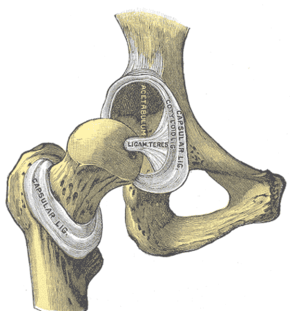Zona orbicularis
The zona orbicularis or annular ligament is a ligament on the neck of the femur formed by the circular fibers of the articular capsule of the hip joint. It is also known as the orbicular zone, ring ligament, and zonular band.[1]
| Zona orbicularis | |
|---|---|
 Capsule of hip-joint (distended). Posterior aspect. (Zona orbicularis labeled at center bottom.) | |
| Details | |
| Identifiers | |
| Latin | zona orbicularis articulationis coxae |
| TA | A03.6.07.002 |
| FMA | 42960 |
| Anatomical terminology | |
Structure
The articular capsule is much thicker above and in front of the joint, where the greatest amount of resistance is required, and thin and loose behind and below the joint. The capsule consists of two sets of fibers, circular and longitudinal. The circular fibers, the zona orbicularis, are most abundant at the lower and back part of the capsule where they form a sling or collar around the femoral neck. Anteriorly they blend with the deep surface of the iliofemoral ligament, and gain an attachment to the anterior inferior iliac spine. [2]
Function
The zona orbicularis and proximal hip joint capsule are poorly understood, but recent studies seem to confirm that the proximal to middle part of the articular capsule, including the zona orbicularis, acts biomechanically as a locking ring wrapped around the femoral neck and thus is a key structure for hip stability in distraction. [3]
Additional images
 Front view of hip joint with capsular ligament largely removed
Front view of hip joint with capsular ligament largely removed
Zona orbicularis used as arthroscopic landmark for iliopsoas muscle.
Notes
This article incorporates text in the public domain from page 334 of the 20th edition of Gray's Anatomy (1918)
- "Zona orbicularis". Irish Health. March 2000. Retrieved 21 June 2009.
- Gray's Anatomy (1918), 7a3
- Ito H. et al (2009)
References
- Gray, Henry (1918). "7. Articulations of the Lower Extremity. a. Coxal Articulation or Hip-joint". Anatomy of the Human Body. Bartleby.
- Ito H, Song Y, Lindsey DP, Safran MR, Giori NJ (January 2009). "The proximal hip joint capsule and the zona orbicularis contribute to hip joint stability in distraction". J. Orthop. Res. Department of Orthopaedic Surgery, Asahikawa Medical College. 27 (8): 989–95. doi:10.1002/jor.20852. PMID 19148941. (Abstract)